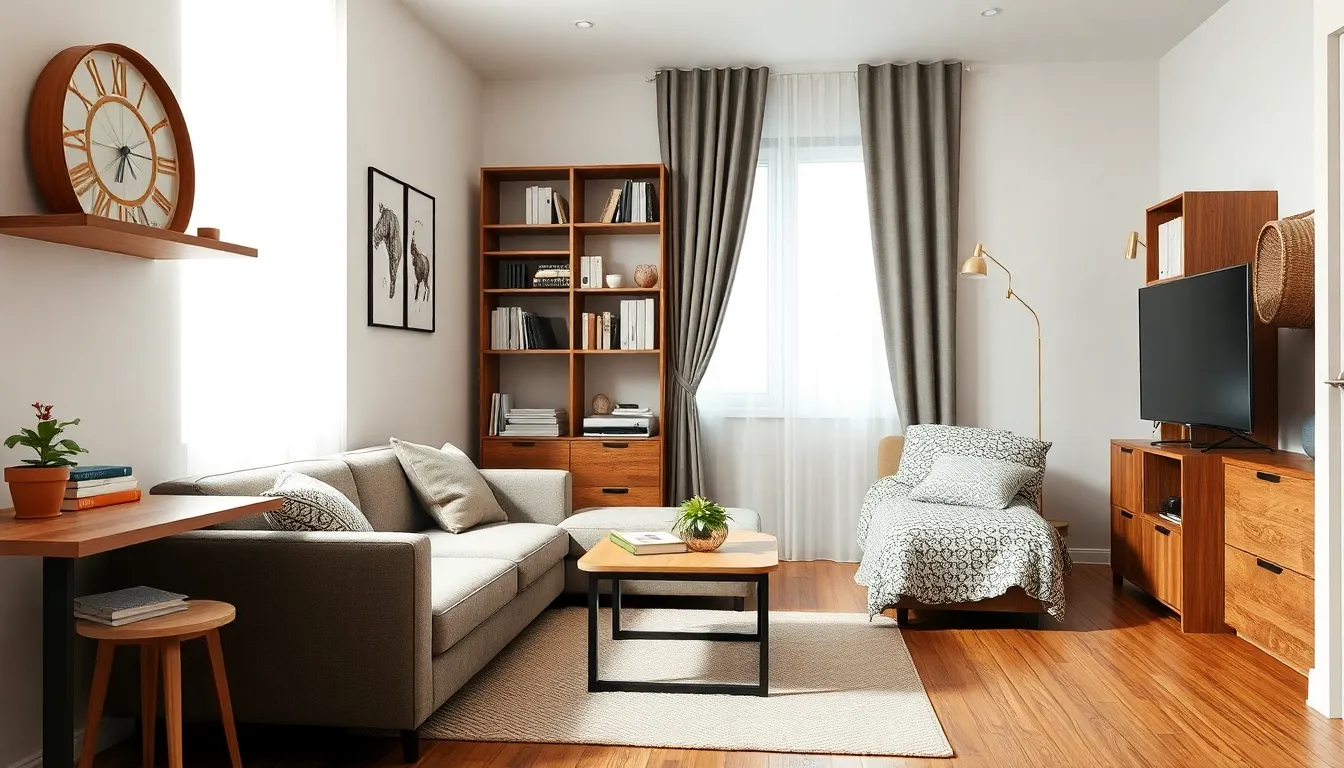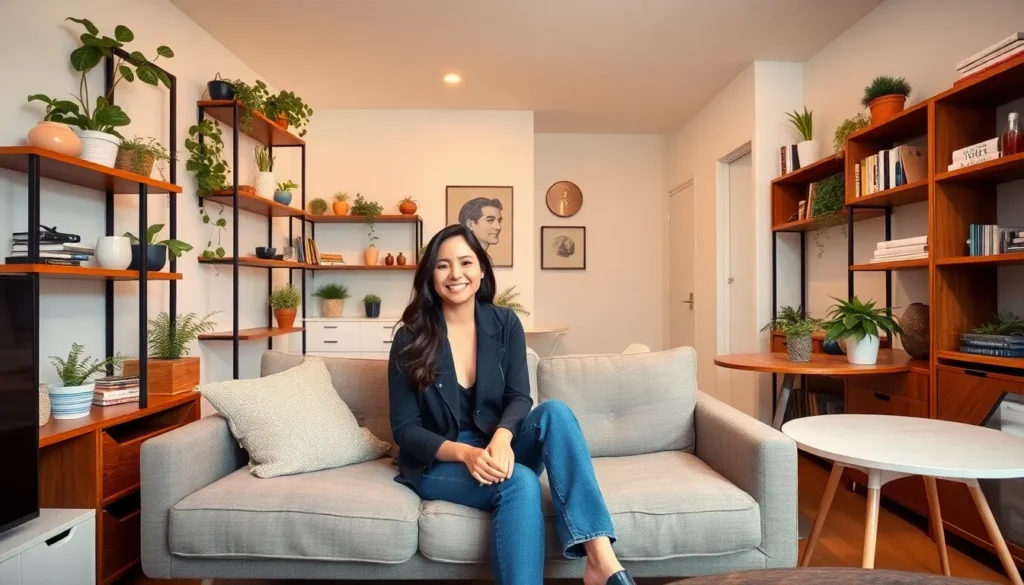In a world where bigger often seems better, compact living is flipping the script. Imagine trading that sprawling mansion for a cozy nook that’s as efficient as it is stylish. Compact living isn’t just about downsizing; it’s about maximizing every square inch and embracing a life that’s both minimalist and full of character.
Picture this: a home where every item has a purpose, and clutter is just a myth. It’s chic, it’s smart, and it’s becoming the go-to solution for urban dwellers and eco-conscious folks alike. Compact living offers a fresh take on how to live well without the extra baggage—literally! So why not dive into the world of compact living and discover how it can transform not just your space, but your lifestyle too?
Table of Contents
ToggleOverview of Compact Living
Compact living focuses on maximizing space efficiency while enhancing functionality. Small homes, like apartments and tiny houses, highlight this philosophy by offering stylish and practical design solutions. By downsizing, individuals often find they can lead a minimalist lifestyle, where every item contributes meaningfully to their space. Reductions in clutter encourage a more organized and serene environment.
This lifestyle appeals especially to urban residents facing high housing costs. Through smart design choices, compact living fosters an ecosystem that values quality over quantity. It emphasizes multi-functional furniture, which allows living areas to adapt to various needs, making even the smallest spaces feel welcoming.
Compact living also aligns with environmentally conscious choices. Individuals embracing this concept can reduce their carbon footprint significantly by consuming fewer resources and minimizing waste. Implementing energy-efficient appliances and sustainable materials enhances the eco-friendliness of these living situations.
Many proponents of compact living enjoy the sense of community it fosters. Smaller spaces often lead to closer interactions with neighbors and encourage shared resources, enriching social connections. Exploring this lifestyle can lead to a greater appreciation for one’s environment and lifestyle simplicity.
Overall, compact living represents a shift in perspective about home sizes, demonstrating that embracing less can lead to more fulfilling living experiences.
Benefits of Compact Living

Compact living offers numerous advantages that appeal to various lifestyles. Embracing this concept enhances overall well-being while promoting efficiency in daily life.
Space Efficiency
Space efficiency stands as one of the fundamental benefits of compact living. Smart design maximizes every square foot in a small home or apartment. Multi-functional furniture, such as sofa beds and expandable tables, allows for versatility in limited areas. Creative storage solutions, including vertical shelving and under-bed compartments, make organization simple. This efficient use of space often leads to a more organized and serene environment, free from clutter.
Cost Savings
Cost savings emerge as a significant advantage of choosing compact living. Smaller homes typically require lower upfront costs, including reduced mortgage or rent payments. Utility expenses diminish as compact living often encourages energy-efficient appliances and sustainable practices. Homeowners and renters frequently find themselves saving on maintenance and cleaning costs as well. Overall, living in a smaller space can lead to substantial financial benefits.
Minimalist Lifestyle
A minimalist lifestyle frequently accompanies compact living. Adopting this approach encourages individuals to evaluate their belongings, retaining only those that hold value or serve a purpose. The elimination of excess creates a calm and functional living environment. Simplifying possessions fosters intentionality in choices and promotes mindfulness. Individuals experience increased satisfaction from their surroundings and gain clarity in their daily lives.
Design Principles for Compact Living
Designing for compact living prioritizes efficiency and versatility. Integration of innovative elements makes smaller spaces functional and inviting.
Multi-Functional Furniture
Multi-functional furniture plays a crucial role in compact living. These pieces serve dual or even triple purposes, enhancing utility without sacrificing style. A sofa bed provides both seating and sleeping options. Storage ottomans can act as footrests and hidden compartments for blankets or books. Nesting tables offer surface space when needed but tuck away easily. Transformability becomes essential in small environments where every inch matters. By incorporating these versatile pieces, residents maximize their living areas while minimizing clutter.
Smart Storage Solutions
Smart storage solutions optimize space in compact living environments. Utilizing vertical space with shelving from floor to ceiling keeps items organized and accessible. Under-bed storage can accommodate seasonal clothing or extra linens, providing hidden storage. Built-in cabinets or drawers eliminate wasted space and enhance the room’s design. Modular shelving systems allow customization based on individual needs. By emphasizing clever storage, residents maintain a tidy and efficient living space, making compact living comfortable and practical.
Challenges of Compact Living
Compact living presents unique challenges that individuals must navigate. These challenges often stem from adapting to smaller spaces while maintaining comfort and functionality.
Limited Space
Limited space creates obstacles for residents in compact homes. Adapting to tight quarters may feel restrictive when trying to arrange furniture and personal belongings. Smaller kitchens limit storage and workspace, affecting cooking and meal prep. Closets often lack sufficient room for seasonal clothing and accessories. Space must also accommodate essential activities, such as work and relaxation, all within a confined area. Creative solutions become vital to ensure everything has a designated place. Utilizing vertical storage and multi-functional furniture can help maximize utility while minimizing clutter.
Personalization and Comfort
Personalization poses a challenge when living in compact spaces. Residents may struggle to express their style due to limited wall space and square footage. Decorating often involves balancing aesthetics with functionality. Achieving comfort in small living areas can require careful furniture selection and arrangement. Choosing pieces that reflect personal tastes while serving multiple purposes enhances the sense of home. Rearranging layouts helps create a cozy atmosphere without overwhelming the space. Successful strategies also involve incorporating personal touches, such as artwork or plants, to infuse character into compact living environments.
Examples of Successful Compact Living Spaces
Compact living manifests in various innovative forms, showcasing creativity and efficiency in home design. Tiny homes and micro-apartments exemplify this trend effectively, providing functional and stylish living spaces.
Tiny Homes
Tiny homes prioritize minimalism and sustainability, often measuring less than 400 square feet. These compact structures encourage efficient use of space through multi-functional furniture and clever storage solutions. Owners often customize interiors to maximize living areas while maintaining personal style. Features like portable designs and eco-friendly materials enhance their appeal. Many individuals opt for tiny homes to embrace a simplified lifestyle, reducing expenses and environmental impact. Communities of tiny homeowners foster a sense of belonging and support, further promoting the benefits of compact living.
Micro-Apartments
Micro-apartments, typically ranging from 200 to 500 square feet, exemplify urban efficiency. Design emphasizes open layouts that create a sense of spaciousness despite limited square footage. Residents benefit from smart storage options and integrated appliances that optimize everyday functionality. These units often feature modular furniture, allowing adaptable living environments. Developers increasingly design micro-apartments to meet the needs of urban dwellers facing high rents and space constraints. This form of compact living caters to young professionals and students seeking affordable, convenient housing solutions.
Compact living offers a refreshing perspective on how individuals can thrive in smaller spaces. By embracing minimalism and efficiency, residents can create functional and stylish environments that reflect their personalities. This lifestyle not only promotes financial savings and reduced environmental impact but also fosters a sense of community and connection.
As urban living continues to evolve, compact homes like tiny houses and micro-apartments provide innovative solutions to modern housing challenges. With the right design principles and smart furniture choices, anyone can transform a limited space into a welcoming haven. Exploring compact living might just lead to a more intentional and fulfilling way of life.



